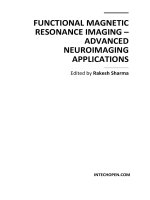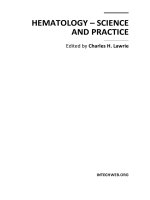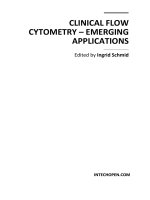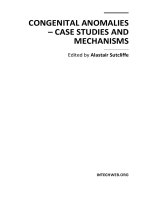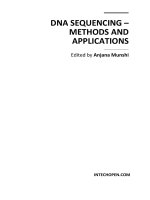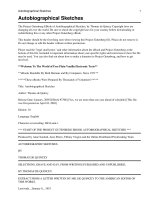SENSOR FUSION FOUNDATION AND APPLICATIONS Edited by Ciza Thomas potx
Bạn đang xem bản rút gọn của tài liệu. Xem và tải ngay bản đầy đủ của tài liệu tại đây (22.33 MB, 238 trang )
SENSOR FUSION -
FOUNDATION AND
APPLICATIONS
Edited by Ciza Thomas
Sensor Fusion - Foundation and Applications
Edited by Ciza Thomas
Published by InTech
Janeza Trdine 9, 51000 Rijeka, Croatia
Copyright © 2011 InTech
All chapters are Open Access articles distributed under the Creative Commons
Non Commercial Share Alike Attribution 3.0 license, which permits to copy,
distribute, transmit, and adapt the work in any medium, so long as the original
work is properly cited. After this work has been published by InTech, authors
have the right to republish it, in whole or part, in any publication of which they
are the author, and to make other personal use of the work. Any republication,
referencing or personal use of the work must explicitly identify the original source.
Statements and opinions expressed in the chapters are these of the individual contributors
and not necessarily those of the editors or publisher. No responsibility is accepted
for the accuracy of information contained in the published articles. The publisher
assumes no responsibility for any damage or injury to persons or property arising out
of the use of any materials, instructions, methods or ideas contained in the book.
Publishing Process Manager Silvia Vlase
Technical Editor Teodora Smiljanic
Cover Designer Jan Hyrat
Image Copyright chang, hui-ju, 2010. Used under license from Shutterstock.com
First published June, 2011
Printed in India
A free online edition of this book is available at www.intechopen.com
Additional hard copies can be obtained from
Sensor Fusion - Foundation and Applications, Edited by Ciza Thomas
p. cm.
ISBN 978-953-307-446-7
free online editions of InTech
Books and Journals can be found at
www.intechopen.com
Contents
Preface IX
Chapter 1 A Dynamic Context Reasoning based
on Evidential Fusion Networks in Home-based Care 1
Hyun Lee, Jae Sung Choi and Ramez Elmasri
Chapter 2 Sensor Fusion for Precision Agriculture 27
Viacheslav I. Adamchuk, Raphael A. Viscarra Rossel,
Kenneth A. Sudduth and Peter Schulze Lammers
Chapter 3 Localization and Tracking Using
Camera-Based Wireless Sensor Networks 41
J.R. Martínez-de Dios, A. Jiménez-González and A. Ollero
Chapter 4 Sensor Fusion for
Enhancement in Intrusion Detection 61
Ciza Thomas
and Balakrishnan Narayanaswamy
Chapter 5 Data Association Techniques
for Non-Gaussian Measurements 77
Stephen C. Stubberud and Kathleen A. Kramer
Chapter 6 Sensor Fusion Techniques in
Navigation Application for Mobile Robot 101
Surachai Panich and Nitin Afzulpurkar
Chapter 7 Real-Time Fusion of Visual Images and Laser Data
Images for Safe Navigation in Outdoor Environments 121
Maria C. Garcia-Alegre, David Martin,
D. Miguel Guinea and Domingo Guinea
Chapter 8 Detecting, Tracking, and Identifying
Airborne Threats with Netted Sensor Fence 139
Weiqun Shi, Gus Arabadjis, Brett Bishop,
Peter Hill, Rich Plasse and John Yoder
VI Contents
Chapter 9 Design, Implementation and Evaluation of a Multimodal
Sensor System Integrated Into an Airplane Seat 159
Bert Arnrich, Cornelia Kappeler-Setz,
Johannes Schumm and Gerhard Tröster
Chapter 10 Sensor Fusion-Based Activity
Recognition for Parkinson Patients 171
Majid Bahrepour, Nirvana Meratnia,
Zahra Taghikhaki, and Paul J. M. Havinga
Chapter 11 A Possibilistic Framework for Sensor
Fusionwith Monitoring of Sensor Reliability 191
Volker Lohweg, Karl Voth and Stefan Glock
Preface
This book as its name suggests deals with the principles and applications of sensor
fusion. Sensor fusion is an important technology, with a very fast growth due to its
tremendous application potential in many areas. It is a method of integrating
information from several different sources into a unified interpretation that extracts
intelligible and more meaningful information. In many cases the source of information
are sensors that allow for perception or measurement of changing environment.
Variety of techniques, architectures, levels, etc. of sensor fusion enables to bring
solutions in various areas of diverse disciplines. Sensor fusion techniques can be
applied to various applications mainly on the data, feature and the decision levels.
The function at data level can be spectral data mining using the digital signal
processing techniques, or the data adaptation using the coordinate transforms/ unit
adjustments or the estimation of parameters using the Kalman filtering/ batch
estimation. The function at the feature level is mainly classification using Pattern
Recognition/ Fuzzy Logic/ Neural Networks. The function at the decision level is the
decide action using Expert Systems/ Artificial Intelligence. This book contains chapters
with different methods of sensor fusion for different engineering as well as non-
engineering applications. Sufficient evidences and analyses have been provided in the
chapters to show the effectiveness of sensor fusion in various applications.
This book provides some novel ideas, theories, and solutions related to the latest
practices and research works in the field of sensor fusion. Advanced applications of
sensor fusion in the areas of mobile robots, automatic vehicles, airborne threats,
agriculture, medical field and intrusion detection are covered in this book.
This book will be of interest to researchers, who need to process and interpret the
sensor data in most of the scientific and engineering field. The book provides some
projections for the future of sensor fusion are provided along with an assessment of
the state-of-the-art and state-of-practice. Hence, this book is intended to serve as a
reference guide in the field of sensor fusion applications. This book will be useful to
system architects, engineers, scientists, managers, designers, military operations
personnel, and other users of sensor fusion for target detection, classification,
identification, and tracking.
X Preface
The chapters in this book provide the foundation on sensor fusion, introducing a
particular sensor fusion application, process models, and identification of applicable
techniques. The materials presented concentrate upon conceptual issues, problem
formulation, computerized problem solution, and results interpretation in various
applications of sensor fusion. Solution algorithms will be treated only to the extent
necessary to interpret solutions and overview events that may occur during the
solution process. A general background in electrical/ electronic engineering,
mathematics, or statistics is necessary for a better understanding of the concepts
presented in the individual chapters. The readers will benefit by enhancing their
understanding of the sensor fusion principles, algorithms, and architectures along
with the practical application of modern sensors and sensor fusion.
Acknowledgements
I worked as an undergraduate student in the area of network security under the
supervision of Professor N. Balakrishnan, Associate Director, Indian Institute of
Science, Bangalore, India. I acknowledge him for introducing me to the applications of
sensor fusion.
Several people have made contributions to this book. Special thanks to all authors of
the chapters for applying their knowledge in the field of sensor fusion in the real-
world problems and also for their co-operation in the timely completion of this book.
Ms. Silvia Vlase and all other InTech staff, took keen interest and ensured the
publication of the book in good time. I thank them for their persistence and
encouragement.
Ciza Thomas
Electronics and Communication Department,
College of Engineering, Trivandrum,
India
Hyun Lee
1
, Jae Sung Choi
2
and Ramez Elmasri
3
1
Daegu Gyeongbuk Institute of Science & Technology
2,3
University of Texas at Arlington
1
South Korea
2,3
USA
1. Introduction
During emergency situations of the patient in home-based care, a Pervasive Healthcare
Monitoring System (PHMS) (Lee et al., 2008) is significantly overloaded with pieces of
information of different known reliability or unknown reliability. The pieces of the
information should be processed, interpreted, and combined to recognize the situation of the
patient as accurate as possible. In such a context, the information obtained from different
sources such as multi-sensors and Radio Frequency Identification (RFID) devices can be
imperfect due to the imperfection of the information itself or unreliability of the sources.
In order to deal with different aspects of the imperfection of contextual information, we
proposed an evidential fusion network based on Dezert-Smarandache Theory (DSmT) (Dezert
& Smarandache, 2009) as a mathematical tool in (Lee et al., 2009). However, context reasoning
over time is a difficult in an emergency context, because unpredictable temporal changes in
sensory information may happen (Rogova & Nimier, 2004). The (Lee et al., 2009) did not
consider dynamic metrics of the context. In addition, some types of contextual information
are more important than others. A high respiratory rate may be a strong indication of the
emergency of the patient others may not be so important to estimate that specific situation
(Padovitz et al., 2005; Wu et al., 2003). The weight of this information may change, due to
the aggregation of the evidence and the variation of the value of the evidence over time.
For instance, a respiratory rate (e.g., 50 Hz) at current time-indexed state (S
t
)shouldhave
more weight compared to a respiratory rate (e.g., 21 Hz) at previous time-indexed state (S
t1
),
because 50 Hz indicates the emergency situation of the patient strongly (Campos et al., 2009;
Danninger & Stierelhagen, 2008).
Thus, we propose a Dynamic Evidential Network (DEN) as a context reasoning method
to estimate or infer future contextual information autonomously. The DEN deals with the
relations between two consecutive time-indexed states of the information by considering
dynamic metrics: temporal consistency and relation-dependency of the information using
the Temporal Belief Filtering (TBF) algorithm. In particular, we deal with both relative
and individual importance of evidence to obtain optimal weights of evidence. By using
the proposed dynamic normalized weighting technique (Valiris et al., 2005), we fuse both
intrinsic and optional context attributes. We then apply dynamic weights into the DEN in
order to infer the situation of the patient based on temporal and relation dependency. Finally,
A Dynamic Context Reasoning based on
Evidential Fusion Networks in Home-based Care
1
2 Will-be-set-by-IN-TECH
we compare the proposed fusion process with a fusion process based on Dempster-Shafer
Theory (DST) (Wu et al., 2003) and Dynamic Bayesian Networks (DBNs) (Murphy, 2002)
that has the same assumption of the environments, so as to show the improvement of our
proposed method in an emergency situation of the patient. The main contributions of the
proposed context reasoning method under uncertainty based on evidential fusion networks
are: 1) Reducing the conflicting mass in uncertainty level and improving the confidence
level by adapting the DSmT, 2) Distinguishing the sensor reading error from new sensor
activations or deactivations by considering the TBF algorithm, and 3) Representing optimal
weights of the evidence by applying the normalized weighting technique into related context
attributes. These advantages help to make correct decisions about the situation of the patient
in home-based care.
The rest of the chapter is organized as follows. Basics of context reasoning are introduced in
section 2. In section 3, we introduce a dynamic context reasoning method based on evidential
fusion network. In section 4, we perform a case study so as to distinguish the proposed fusion
process with traditional fusion processes. We compare and analyze the results of our approach
with those of DST and DBNs to show the improvement of our approach in section 5. We
introduce some related works in section 6. We then conclude this work in section 7.
2. Basics of context reasoning
2.1 Characteristics of the evidence
Multi-sensors such as medical body sensors, Radio Frequency Identification (RFID) devices,
environmental sensors and actuators, location sensors, and time stamps are utilized in a
PHMS (Lee et al., 2008). These sensors are operated by pre-defined rules or learning processes
of the expert systems. They often have thresholds to represent the emergency status of the
patient or to operate actuators. Each sensor can be represented by an evidential form such
as 1 (active) and 0 (inactive) based on the threshold. Whenever the state of a certain context
associated with a sensor is changed, the value of a sensor can change from 0 to 1 or from
1 to 0. For instance, a medical body sensor activates the emergency signal if the sensor
value is over the pre-defined threshold. An environmental sensor operates the actuator based
on the fuzzy systems. A location detecting sensor operates if a patient is within the range
of the detection area. Thus, we can simply express the status of each sensor as a frame:
= T hreshol d
over
, Threshold
notover
= 1, 0.
Sensor data are inherently unreliable or uncertain due to technical factors and environmental
noise. Different types of a sensor may have various discounting factors (D)
(0 D 1).
Hence we can express the degree of reliability, which is related in an inverse way to the
discounting factor. The smaller reliability (R) corresponds to a larger discounting factor (D):
R
= 1 D (1)
For inferring the activity of the patient based on evidential theory, reliability discounting
methods that transform beliefs of each source are used to reflect the sensor’s credibility, in
terms of discount factor (D)
(0 D 1). The discount mass function is defined as:
m
D
(X)=
(1 D)m(X) X
D
+(1 D) m() X =
(2)
where the source is absolutely reliable (D=0), the source is reliable with a discounting factor
(D)
(0 < D < 1), and the source is completely unreliable (D=1).
2
Sensor Fusion - Foundation and Applications
Fig. 1. A Relation-dependency approach
2.2 Context classification
The quality of a given piece of contextual information of a patient should be presented
by some generalized forms of context classification (Razzaque et al., 2007) to determine
reliable contextual information of a patient. However, it is an impossible task to build a
general context classification to capture all aspects of the patient’s contextual information
in smart spaces. The numbers of ways to describe an event or an object are unlimited
and there are no standards or guidelines regarding granularity of contextual information.
In particular, the quality of a given piece of contextual information is not guaranteed by
uncertainty. Thus, we defined the relation-dependency approach as a context classification
based on spatial-temporal limitations which has three categories: 1) discrete environmental
facts; 2) continuous environmental facts; and 3) occupant-interaction events as shown in
Figure 1. These relation-dependency components consist of "Context state (S(t))", defined
as the collection and aggregation of activated or deactivated context attributes (Lee et al.,
2009), "Sensor’s static threshold (T(t))", "Location of the patient (R(t))", "Primary context (P)",
"Secondary context (S)" and "Preference (Pref)".
2.3 Context modeling
We defined a state-space based context modeling with an evidential form as a generalized
context modeling to represent the situation of the patient using context concepts that are
similarly used in (Padovitz et al., 2005) and to improve the quality of a given piece of
contextual information by reducing uncertainty. Within the proposed modeling, all possible
values and their ambiguous combinations are considered to improve the quality of data in the
given time (t) and location (R ). We assign a probability value to each related set to achieve
an efficient uncertainty representation. This can transfer a qualitative context information
to a quantitative representation. Static weighting factors of the selected data are applied
to represent the quality of data initially within the given t and R. This context modeling
consists of a hierarchical interrelationship among multi-sensors, related contexts, and relevant
activities within a selected region as shown in Figure 2. Each context concept is defined as
follow.
A context attribute, denoted by
i
, is defined as any type of data that is utilized in the process
of inferring situations. It is often associated with sensors, virtual or physical, where the value
of a sensor reading denotes the value of a context attribute at a given t, denoted by
t
i
.
3
A Dynamic Context Reasoning based on Evidential Fusion Networks in Home-based Care
4 Will-be-set-by-IN-TECH
Context State
Situation Space
Context Attributes
Sensor /
RFID tag K
Sensor /
RFID tag 2
Sensor /
RFID tag 1
Relevant
Activities
···
Elderly Person
&Patient
Related
Contexts
Region 1
(Bedroom)
Region 2
(Living Room)
Region K
(Kitchen )
Object
(Sofa)
Object
(Heater)
Object
(Body)
···
···
···
···
Fig. 2. An inter-relationship based on state-space context modeling
A context state, denoted by a vector S
i
, describes the current state of the applied application
in relation to a chosen context. It is a collection of N context attribute values to represent a
specific state of the system at the given t. A context state is denoted as S
t
i
=(
t
1
,
t
2
, ,
t
N
),
where each value
t
i
corresponds to the value of an attribute
i
at the given t. Whenever
contextual information is recognized by certain selected sensors that can be used to make
context attributes, a context state changes its current state depending on the aggregation of
these context attributes.
A situation space, denoted by a vector space R
i
=(
R
1
,
R
2
, ,
R
K
), describes a collection of
regions corresponding to some pre-defined situations. It consists of K acceptable regions for
these attributes. An acceptable region
R
i
is defined as a set of elements V that satisfies a
predicate P, (i.e.,
R
i
= V P(V)). A particular contextual information can be performed or
associated with a certain selected region.
Given a context attribute i,aquality of data
i
associates weights
1
,
2
, ,
M
with combined
attributes of values
t
1
+
R
1
,
t
2
+
R
2
, ,
t
N
+
R
K
of i, respectively, where
M
j
=1
j
= 1. The
weight
j
(0, 1] represents the relative importance of a context attribute
j
compared to
other context attributes in the given t and R. For instance, a higher respiratory rate may be
a strong indication of the fainting situation of a patient while other context attributes such
as the blood pressure and the body temperature may not be so important to estimate that
specific situation of the patient. In addition, a context attribute (
t
i
) within a context state
(S
t
i
=(
t
1
,
t
2
, ,
t
N
)) has various individual weights for
t
i
per different time intervals in the
same situation space (
R
i
). For example, a respiratory rate (50Hz) at the current time-indexed
state (S
t
) is a strong indication of the fainting situation of the patient compared to a respiratory
rate
(21Hz) at previous time-indexed state (S
t1
). The same context attribute can have
different degrees of importance in different contexts. We only consider the quality of data with
the pre-defined context attributes, a selected region, and relevant activities initially. We then
apply dynamic weights into both relative and individual importance of evidence to obtain an
optimal weight of evidence.
2.4 Dezert-Smarandache Theory (DSmT)
The basic idea of DSmT (Dezert & Smarandache, 2004; 2006; 2009) is to consider all elements
of as not precisely defined and separated. No refinement of into a new finer set
re f
of
disjoint hypotheses is possible in general, unless some integrity constraints are known, and in
such case they will be included in the DSm model of the frame. Shafer’s model (Shafer, 1976)
assumes to be truly exclusive and appears only as a special case of the DSm hybrid model
in DSmT. The hyper-power set, denoted by D
, is defined by the rules 1, 2 and 3 without
additional assumption on but the exhaustivity of its elements in DSmT.
4
Sensor Fusion - Foundation and Applications
A Dynamic Context Reasoning based on Evidential Fusion Networks in Home-based Care 5
1. ,
1
, ,
n
D
2. If
1
,
2
D
,then
1
2
and
1
2
belong to D
3. No other elements belong to D
, except those obtained by rules 1) or 2)
When Shafer’s model M
0
() holds, D
reduces to 2
. Without loss of generality, G
is equal
to D
if the DSm model is used, depending on the nature of the problem.
2.5 Combination rules (conjunctive and disjunctive)
As a conjunctive combination rule, the proportional conflict redistribution no. 5 (PCR5)
(Smarandache & Dezert, 2005) are defined based on the conjunctive consensus operator for
two sources cases by:
m
12
(X)=
X
1
,X
2
G
X
1
X
2
=X
m
1
(X
1
)m
2
(X
2
) (3)
The total conflicting mass drawn from two sources, denoted by k
12
,isdefinedas:
k
12
=
X
1
,X
2
G
X
1
X
2
=
m
1
(X
1
)m
2
(X
2
)=
X
1
,X
2
G
X
1
X
2
=
m(X
1
X
2
) (4)
The total conflicting mass is the sum of partial conflicting masses based on Equations (3) and
(4). If the total conflicting mass k
12
is close to 1, the two sources are almost in total conflict.
Whereas if the total conflicting mass k
12
is close to 0, the two sources are not in conflict.
Within the DSmT framework, the PCR5 combination rule redistributes the partial conflicting
mass only to the elements involved in that partial conflict. For this approach, first, the PCR5
combination rule calculates the conjunctive rule of the belief masses of sources. Second, it
calculates the total or partial conflicting masses. And last, it proportionally redistributes
the conflicting masses to nonempty sets involved in the model according to all integrity
constraints. The PCR5 combination rule is defined for two sources (Dezert & Smarandache,
2009): m
PCR5
()=0and(X = ) G
,
m
PCR5
(X)=m
12
(X)+
YG
X
XY=
[
m
1
(X)
2
m
2
(Y)
m
1
(X)+m
2
(Y)
+
m
2
(X)
2
m
1
(Y)
m
2
(X)+m
1
(Y)
]
(5)
where m
12
and all denominators such as m
1
(X)+m
2
(Y) and m
2
(X)+m
1
(Y) differ from
zero(0). If a denominator is zero, that fraction is discarded. All sets in formulas are in canonical
forms. For example, the canonical form of X
=(A B) (A B C) is A B.
In addition, a disjunctive combination rule is used for Temporal Belief Filtering (TBF)
(Ramasso et al., 2006). For instance, the TBF, which reflects that only one hypothesis
concerning activity is true at each time-indexed state, ensures a temporal consistency with an
exclusivity. Within a TBF, the disjunctive rule of combination (m
(.))isusedsoastocompute
prediction from previous mass distributions and model of evolution. m
(.) is defined for two
sources: m
()=0and(C) ,
m
(C)=
i,j
C
=X
i
Y
j
m
1
(X
i
)m
2
(Y
j
), (C = ) (6)
5
A Dynamic Context Reasoning based on Evidential Fusion Networks in Home-based Care
6 Will-be-set-by-IN-TECH
Context State 1
Activity 1
Belief or GPT
Multi-valued
Mapping
Combination
of Rule
Patient
…
Activity 2 Activity K
Context State 2 Context State K
…
WF
Context
Attribute 1
Context
Attribute 2
Context
Attribute K
…
Weighting
Factor
WF
Discounting
Factor 1
DF 2 DF K
Fig. 3. An Evidential Fusion Network (EFN)
The core of a belief function given by m
(C) equals the union of the cores of Bel(X) and
Bel
(Y). This rule reflects the disjunctive consensus and is usually preferred when one knows
that one of the source X or Y is mistaken but without knowing which one between X and Y.
2.6 Pignistic transformations (CPT and GPT)
When a decision must be taken, the expected utility theory, which requires a classical pignistic
transformation (CPT) from a basic belief assignment m
(.) to a probability function P.,is
defined in (Dezert et al., 2004) as follows:
P
A =
X2
X A
X
m(X) (7)
where
A denotes the number of worlds in the set A (with convention 0/0 = 1, to define
P
0). PA corresponds to BetP(A) in Smets’ notation (Smets, 2000). Decisions are achieved
by computing the expected utilities. In particular, the maximum of the pignistic probability is
used as a decision criterion.
Within the DSmT framework, it is necessary to generalize the CPT to take a rational decision.
This generalized pignistic transformation (GPT) is defined by (Dezert et al., 2004):
(A) D
,
P
A =
XD
C
M
(X A)
C
M
(X)
m(X) (8)
where C
M
(X) denotes the DSm cardinal of a proposition X for the DSm model M of the
problem under consideration. In this case, if we adopt Shafer’s model M
0
(), Equation (8)
reduces to Equation (7) when D
reduces to 2
. For instance, we gets a basic belief assignment
with non null masses only on X
1
, X
2
and X
1
X
2
. After applying GPT, we get:
P
= 0, PX
1
X
2
= 0
P
X
1
= m(X
1
)+
1
2
m(X
1
X
2
)
PX
2
= m(X
2
)+
1
2
m(X
1
X
2
)
PX
1
X
2
= m(X
1
)+m(X
2
)+m(X
1
X
2
)=1
6
Sensor Fusion - Foundation and Applications
A Dynamic Context Reasoning based on Evidential Fusion Networks in Home-based Care 7
2.7 Evidential Fusion Network (EFN)
Based on the proposed state-space context modeling, the Evidential Fusion Network (EFN) is
constructed as shown in Figure 3. Within a EFN, context reasoning is performed to make a
high confidence level of the situation of the patient. The fusion process is performed to infer
the activity of the patient along the EFN as follows.
1. (Define the Frame of Discernment): the evidential form represents all possible values of
the sensors and their combination values.
2. (Sensor’s Credibility): reliability discounting mass functions defined as Equations (1) and
(2) transform beliefs of individual evidence to reflect the credibility of the sensor. A
discounting factor (D) is applied to each context attribute within an EFN.
3. (Multi-valued Mapping): a multi-valued mapping represents the evidence to the same
problem with different views. In particular, it can be applied to the context attributes so as
to represent the relationships between sensors and associated objects by translating mass
functions. A multi-valued mapping also can be applied to the related context state so
as to represent the relationships among context attributes. Each context state consists of
different pre-defined static weight of the evidence (Relative importance).
4. (Consensus): several independent sources of the evidence combine the belief mass
distributions on the same frame to achieve the conjunctive consensus with the conflict
mass. The PCR5 combination rule (Smarandache & Dezert, 2005) is applied to context
states to obtain a consensus that helps to recognize the activity of the patient.
5. (Degree of Belief): Lower (Belief (Bel)) and upper bounds (Plausibility (Pl)) on probability
is calculated to represent the degree of belief. Then the uncertainty levels (Pl - Bel)ofthe
evidence in evidential framework is measured by using belief functions such as Belief (Bel)
and Plausibility (Pl) after applying the PCR5 combination rule.
6. (Decision Making): The expected utility and the maximum of the pignistic probability
such as Generalized Pignistic Transformations (GPT) is used as a decision criterion. The
situation of the patient is inferred by calculating the belief, uncertainty, and confidence
(i.e., GPT) levels of contextual information within an EFN.
3. Dynamic context reasoning
As shown in Figure 4, contextual information of a patient has the association or correlation
between two consecutive time-indexed states. The EFN should include a temporal dimension
for dealing with this context reasoning over time. Therefore, we introduce a dynamic context
reasoning method in this section.
3.1 Temporal Belief Filtering (TBF) for relation-dependency
Depending on temporal changes, the values of the sensor at the current time-indexed state
(S
t
) are evolved by the measured values at the previous time-indexed state (S
t1
), because the
belief mass distribution can not vary abruptly between two consecutive time-indexed states.
In order to deal with this evolution, we utilize the Autonomous Learning Process (ALP)
principle that has three states: 1) Initial State, 2) Reward State, and 3) Final Decision State
as shown in Figure 5. This ALP principle is performed based on the Q-learning technology
represented by (Roy et al., 2005). In Equation (9), X
t
is the current state, m(.) is the belief mass
distribution, D is the discounting factor, and Re is the reward state to help decision making in
7
A Dynamic Context Reasoning based on Evidential Fusion Networks in Home-based Care
8 Will-be-set-by-IN-TECH
Context State 1
Activity 1
Belief or GPT
Multi-valued
Mapping
Combination
of Rule
Patient
Activity 2 Activity K
Context State 2 Context State K
È
WF
Context
Attribute 1
Context
Attribute 2
Context
Attribute K
È
Weighting
Factor
WF
Error
Rate 1
ER 2 ER K
Context State 1
Activity 1
Belief or GPT
Multi-valued
Mapping
Combination
of Rule
Patient
È
Activity 2 Activity K
Context State 2 Context State K
È
WF
Context
Attribute 1
Context
Attribute 2
Context
Attribute K
È
Weighting
Factor
WF
Error
Rate 1
ER 2 ER K
Context State 1
Activity 1
Belief or GPT
Multi-valued
Mapping
Combination
of Rule
Patient
…
Activity 2 Activity K
Context State 2 Context State K
…
WF
Context
Attribute 1
Context
Attribute 2
Context
Attribute K
…
Weighting
Factor
WF
Discounting
Factor 1
DF 2 DF K
Static Evidential Network
Static Evidential Network
Static Evidential Network
Temporal
Links
t
t+1
t+2
Temporal
consistency
Relation-
Dependency
Fig. 4. EFN with a temporal dimension
Initial
State
Final
Decision
State
Enter
Activated
Sensors
Reward State
Prediction
Fusion
Learning
Updated
Rule
Policy
Decision
Rule
Fig. 5. Autonomous Learning Process (ALP) Principle
final decision state. We can support dynamic metrics (e.g., the evolution of the upper bounds
or lower bounds of the pre-defined criteria).
Q
(X
t
, m
t
(.)) (1 m
t
(.))Q(X
t
, m
t
(.))+
m
t
(.)(Re + D max m
t1
(.)Q(X
t1
, m
t1
(.)) (9)
In particular, TBF operations: prediction, fusion, learning and update are performed in reward
state of the ALP principle to obtain the relation-dependency. The TBF ensures temporal
consistency with the exclusivity between two consecutive time-indexed states when only one
hypothesis concerning activity is true at each time. The TBF assumes that the general basic
belief assignment (GBBA) at the current time stamp t is close to the GBBA at the previous
time stamp t
1. Based on this assumption, the evolution process predicts a current GBBA
taking the GBBA at t
1 into account. The TBF that operates at each time stamp t consists in
four steps: 1) Prediction, 2) Fusion, 3) Learning and 4) Updated rule if required. For instance,
if the activity of the patient was fainting (F)att
1 then it would be partially fainting (F)at
t. This is an implication rule for fainting (F) which can be weighted by a confidence value of
m
F
.[0, 1]. In this case, the vector notation of a GBBA defined on the frame of discernment
()isused:
m
=[ m
() m
(F) m
(F) m
(F F)]
8
Sensor Fusion - Foundation and Applications
A Dynamic Context Reasoning based on Evidential Fusion Networks in Home-based Care 9
The evolution process can be interpreted as a GBBA defined as:
m
F
=[ 01 Pl
F
Bel
F
Pl
F
Bel
F
]
T
(10)
3.1.1 Prediction
Depending on current model M with only two focal sets, the disjunctive rule of combination
is used to compute prediction from the previous GBBA at t
1 and model of evolution using
Equation (6). The disjunctive rule of combination does not allow to assign more belief to
a hypothesis than does the previous GBBA. It is well suited for the autonomous evolution
process under uncertainty:
ˆ
m
t,M
= m
t
1
(M
) m
M
(11)
where m
t
1
is the previous GBBA and m
M
is model of evolution.
For instance, the prediction for fainting (F) situation of the patient at time stamp t is defined
as:
ˆm
t,F
=
0
(1 Pl
F
) m
t
1
(F)
Bel
F
m
t1
(F)
1 [((1 Pl
F
) m
t
1
(F)) + Bel
F
m
t
1
(F)]
(12)
when m
F
= 1orwhenm
F
= 0, the prediction reflects a total confidence or a total ignorance
with the current time-indexed state, respectively.
3.1.2 Fusion, learning and updated rule
Prediction (
ˆ
m
t,M
)andmeasurement (m
t
) represent two distinct pieces of the information. Fusion
of the two distinct pieces of the information leads to a new GBBA whose conflict value (C
F
)is
relevant for belief learning and update requirement. In this case, conflict value (C
F
), which is
similar to k
12
of Equation (4), is calculated by the conjunctive rule of combination of
ˆ
m
t,M
and
m
t
:
C
F
=
ˆ
m
t,M
(M
) m
t
() (13)
In addition, policy is required so as to analyze whether the current model M is valid or not.
If C
F
is not greater than the pre-defined threshold (T), the model at t 1 is kept as valid at
t. However, if C
F
exceeds the T, the model is evolved based on the result of the conjunctive
rule of combination of
ˆ
m
t,M
and m
t
. Depending on the applied policy, the evolution process
(m
t,M
) (i.e., learning) is performed as below:
m
t,M
=
ˆ
m
t,M
(M
) m
t
, if C
F
T
m
t
1,M
, if C
F
< T
(14)
After a learning, a fading memory process (F
a
) has been embedded so as to reduce the
relation-dependency of the pieces of long past information even though the cumulative sum
of conflict value (C
F
) between
ˆ
m
t,M
and m
t
is lower than the pre-defined threshold (T)during
long time intervals. A fading memory process (F
a
) resets the cumulative sum of C
F
as a zero
(0) and
ˆ
m
t
+w,M
is equal to m
t
+w
based on time window size (W),whichischosenasaconstant
value (C). Then, updated rule is applied to the model of evolution repeatedly after F
a
is applied
to m
t,M
.
m
t
+w,M
=
(1) F
a
C
F
= 0,if W= C
ˆ
m
t
+w,M
= m
t
+w
(2) m
t,M
(F
a
)
(15)
9
A Dynamic Context Reasoning based on Evidential Fusion Networks in Home-based Care
10 Will-be-set-by-IN-TECH
3.1.3 Decision rule
A decision is taken by the maximum of GPT (i.e., Equation (8)) within the DSmT framework
after the evolution process is performed. We adopt Shafer’s model (Shafer, 1976) in order to
compare our approach with DBNs, which can get a BBA with non null masses only on
1
and
2
(i.e., P
1
2
= m(
1
)+m(
2
)=1) where
1
and
2
are hypotheses of the frame of
discernment () (i.e., focal elements of the state within the frame of the set).
It is required to assess the recognition performance of a time-indexed state to decide whether
a temporal sequence of the state has a false alarm or a new sensor activation/deactivation
within the defined time window size (W). It is necessary to find a quality criterion without
references to assess this performance. We defined D
F
as the differentiation of GPTs of two
consecutive time-indexed states. The
¯
D
F
is defined as the mean of D
F
(i.e.,
D
F
W
) within the
defined W as the chosen criterion (i.e., Equation (16)) in order to distinguish a sensor reading
error from new sensor activations or deactivations). As shown in Equation (17), if
¯
D
F
is less
than , there is no error within W.If
¯
D
F
is located between and , a false alarm happens.
And if
¯
D
F
is greater than , the emergency situation of the patient progress.
¯
D
F
1
W
i=1,W
D
i
F
(16)
Decision
(De)=
No errors within the W , if
¯
D
F
<
False alarm , if
¯
D
F
<
Emergency Progress , if
¯
D
F
(17)
where is the defined false alarm threshold and is the defined emergency progress threshold
for the chosen criterion. In this case, the value of is always lower than that of ,because
we assume that the false alarm does not often happen when the new sensor activation or
deactivation is detected by the expert system in emergency situation of the patient. Based on
the defined threshold (T) for conflict value (C
F
) and time window size (W), we can distinguish
a sensor reading error from new sensor operations. Then, we perform evolution operations
with dynamic evidential network (DEN) in order to improve the confidence (i.e., GPT) level
of contextual information.
3.2 Evolution operations with DEN
The DEN is constructed based on the EFN with a temporal dimension as shown in Figure 6.
Within a DEN, context reasoning is performed to find a false alarm in captured contexts and
to make a high confidence level of the situation of the patient. First, we define the threshold
(Te) of the GPT level for the emergency situation of the patient. Second, we calculate the GPT
level at each time-indexed state using a TBF with defined T and W. And last, if the GPT level
is over the defined Te for four continuous time-indexed states, we make a decision about the
situation of the patient as an emergency. We assume that the initial prediction is equal to the 1
st
measurement at 1
st
time-indexed state (S
1
). The consecutive processing of two combination
rules (i.e, disjunctive rule and conjunctive rule) is well adapted to EFN to update the belief
mass distribution of EFN at time-indexed states. In Figure 6, we define n time intervals and
time window sizes W to reflect a fading memory process
(F
a
) to the pervasive healthcare
system. The F
a
reduces long past contextual information of the patient. Depending on D
F
and
¯
D
F
, we trace the emergency progress which can check a false alarm. We then make an optimal
time window size (W) that is applied to the evolution process.
10
Sensor Fusion - Foundation and Applications
A Dynamic Context Reasoning based on Evidential Fusion Networks in Home-based Care 11
Context Sensor Non-Activated Activated
Type Type Regular (1) Warning (2) Warning (3) Emergency (4)
Respiratory Rate 1520 Hz 1314 or 2130 Hz 1112 or 3140 Hz 10 bel o w or 41 over Hz
Intrinsic Blood Pressure 12090 mmHg 121130 or 8189 mmHg 131140 or 7180 mmHg 141 over or 6170 mmHg
Body Temperature 36.637
C 36.136.5 or 37.138
C 35.636 or 38.139
C 35.5
C below or 39.1
Cover
Location The motion detector installed in the ceiling catches the RF signal attached on the patient
Optional Motion The motion detector installed in the door catches the RF signal attached on the patient
Pressure The pressure sensor attached on the sofa catches the weight of the patient
Table 1. Pre-defined Rules of a Context Attribute
11
A Dynamic Context Reasoning based on Evidential Fusion Networks in Home-based Care
Fig. 6. The Proposed DEN for n time intervals
3.3 An optimal weight for evidence
3.3.1 Pre-defined rule of a context attribute
We define rules of a context attribute to represent dynamic weights of a context attribute as
shown in Table 1. We assume that the ratio of total weights of optional context attributes
O
(
i
) is equal to that of intrinsic context attributes I(
i
) in order to apply the rule of
combination. Within a EFN, each context state has the same weight (e.g., the weight is equal
to 0.5). We apply more C
(a
k
t
), which reflects the increase or decrease degree of a particular
context attribute, to the activated case (i.e., Emergency (4)) compared to the non-activated case
(i.e., Warning (2 and 3) and Regular (1)), because the activated case is more important than the
non-activated case in an emergency situation of the patient. In addition, we apply more C
(a
k
t
)
to the level increased case (i.e., L(a
k
t
+1
) > L(a
k
t
+1
)) compared to the level decreased case (i.e.,
L
(a
k
t
+1
) < L(a
k
t
+1
)), where L(a
k
t
+1
) reflects the level of a particular context attribute. The level
increased case is more important than the level decreased case in an emergency situation of
the patient. Thus, we calculate the weight of an intrinsic context attribute as below.
1. initial O
(
i
) = I(
i
) =0.5
2. if all L
(a
k
t
)=L(a
k
t
+1
),thenC(a
k
t
+1
) =0
3. else if L
(a
k
t
+1
) > L(a
k
t
) and L(a
k
t
+1
) = 4, then C(a
k
t
+1
) =2
4. else if L
(a
k
t
+1
) < L(a
k
t
) and L(a
k
t
) = 4, then C(a
k
t
+1
) =-
5. else if L
(a
k
t+1
) > L(a
k
t
) and L(a
k
t+1
)=4, then C(a
k
t+1
) =3
6. else if L
(a
k
t+1
) < L(a
k
t
) and L(a
k
t
)=4, then C(a
k
t+1
) =-2
with two % values and (i.e.,
).
3.3.2 A normalized weighting technique
We calculate the relative weight of a context attribute based on Multi-Attribute Utility
Theory (MAUT) (Valiris et al., 2005; Winterfeld & Edwards, 1986) to setup the initial weight
of a context attribute within a given context state. The weights are determined by their
importance in regarding to a specific situation of the patient. In particular, we construct a scale
12
Sensor Fusion - Foundation and Applications
A Dynamic Context Reasoning based on Evidential Fusion Networks in Home-based Care 13
Sensor Type Regular Emergency Relative Weight
˜
u
Respiratory Rate Scale-R (5) Scale-E (55) 0.6
Blood Pressure
Scale-R (5) Scale-E (15) 0.2
Body Temperature
Scale-R (5) Scale-E (15) 0.2
Location Scale-R (5) Scale-E (10) 0.25
Motion
Scale-R (5) Scale-E (10) 0.25
Pressure
Scale-R (5) Scale-E (25) 0.50
Table 2. An example of Relative Weight of a Context Attribute
representing the properties of the levels of a context attribute to evaluate context attributes.
For instance, we assume that the scale from 0 (e.g., the least affection) to 55 (e.g., the most
affection) for the situation serves as measure of the evaluation as shown in Table 2. We
pre-define the scale of a context attribute then calculate the relative importance of a context
attribute using Equation (18).
˜
u
=
v
/
N
w=1
(
w
) (18)
where
˜
u
defines the relative weight of a context attribute,
v
is the sum of the value of
Scale-R and Scale-E for one sensor type, and
N
w
=1
(
w
) is the total sum of the value of Scale-R
and Scale-E. After calculating the relative weight of a context attribute, we redistribute the
weight of a context attribute over time based on the pre-defined rule of a context attribute.
Let
1
,
2
, ,
k
, ,
k+m
, ,
N
denote an initial relative weight associated with a
given context state S
i
t
for fusion process. Within the same location, a normalized weighting
technique for individual difference between two time-indexed states is applied to each context
attribute as below.
1. Repeat for each optional context attribute k:
k
=
i
, where i defines an initial weight
2. Repeat for each intrinsic context attribute k:
if all L
(a
k
t
)=L(a
k
t
+1
) or all C(a
k
t
+1
) are equal,
then all
k
=
i
else if any L(a
k
t
) = L(a
k
t
+1
) or any C(a
k
t
+1
) is different,
then
ˆ
k
=
i
/
N
j
=1
(
j
C(a
j
t
+1
)),
where
ˆ
k
defines a new weight for a context attribute
3.4 Dynamic conte x t reasoning
Based on the proposed DEN, the dynamic weighting is applied to each evidence to make
a high GPT level of the situation of the patient compared to the others. First, we calculate
the GBBA of SEN initially using evidential operations at 1
st
time-indexed state. Second, we
apply the updated weight into each context attribute from 2
nd
time-indexed state using the
proposed normalized weighting technique. Finally, we calculate the confidence level (i.e.,
GPT) of contextual information. The proceduresof dynamic context reasoning consist of seven
steps.
1. (Measure a GBBA of SEN): Initially, we measure a GBBA of SEN using evidential
operations at time stamp t. The first prediction (
ˆ
m
t
1
,M
) is equal to measurement (m
t
1
)at
time-indexed state S
1
.
13
A Dynamic Context Reasoning based on Evidential Fusion Networks in Home-based Care
